25 Most Common Types of Butterflies in Illinois (With Pictures)
-
Jessica Kim
- Last updated:
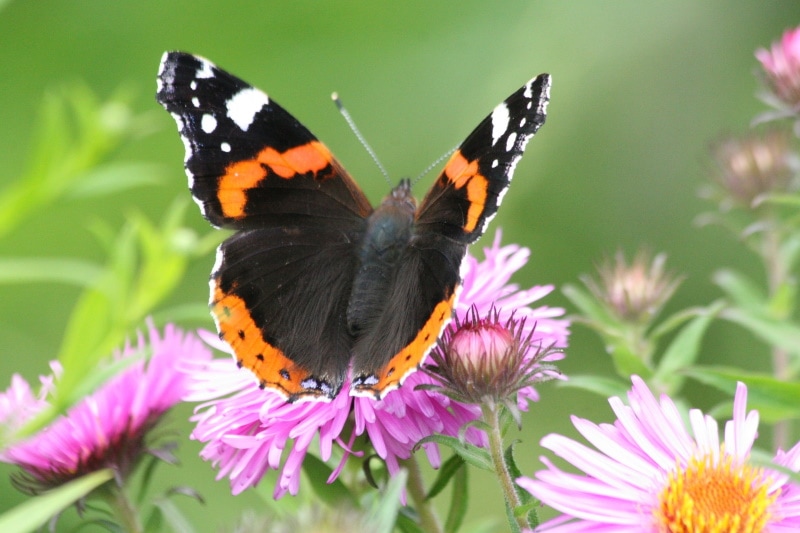
Illinois is home to over 100 species of butterflies. While many natural habitats of butterflies consist of ponds, rivers, prairie lands, and forests, you can find plenty of species in backyards and urban areas.
With Illinois’ cold winters, butterflies are often welcomed as vibrant signals of the end of winter. Some butterflies emerge in Illinois in the spring, and they’re most abundant in the summer. If you’re interested in butterfly watching, you can expect to encounter these common species more frequently than others.
The 25 Most Common Types of Butterflies in Illinois
1. American Lady
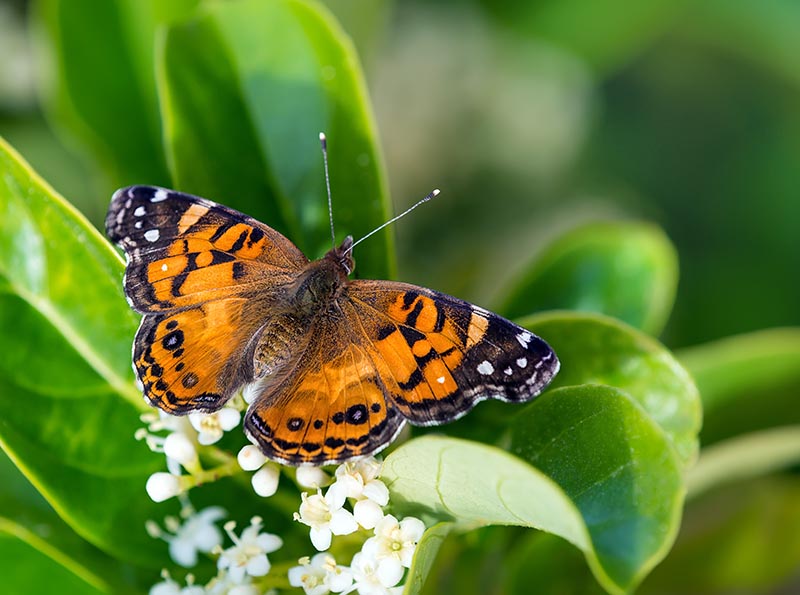
| Scientific Name: | Vanessa virginiensis |
| Colors: | Orange, black, white, brown, pink |
American Ladies are known to be one of the hardiest species of butterflies and may even be able to overwinter in Illinois. This butterfly has two forms that vary in color. The early-season American Lady is orange with black edges and white spots. The late-season form has more muted colors and fewer black markings.
American Ladies lay yellow-green eggs, and the larvae prefer to eat from plants belonging to the Aster family. Some popular choices include the Pennsylvania Everlasting, Spoonleaf Purple Everlasting, and Caribbean Purple Everlasting.
2. Black Swallowtail
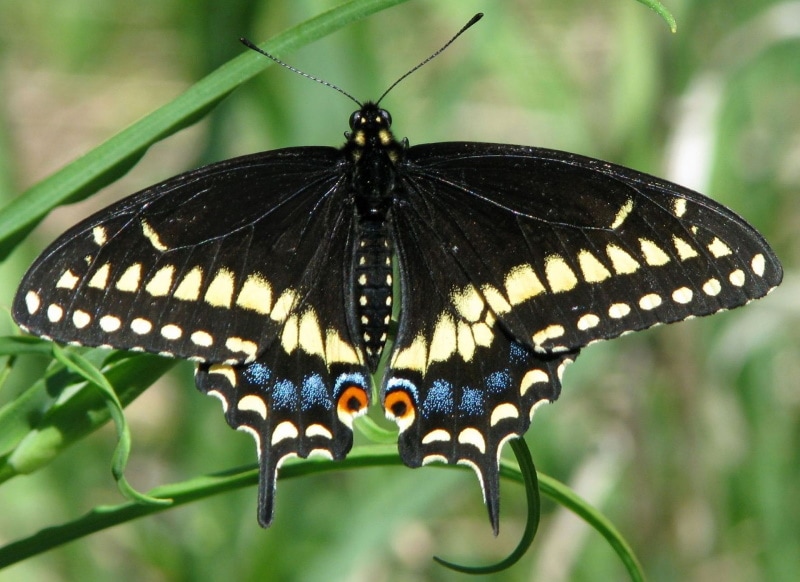
| Scientific Name: | Papilio polyxenes |
| Colors: | Black, white, orange, blue |
Upon first glance, the Black Swallowtail may look like a solid black butterfly. However, if you’re able to get a closer look, you can see a detailed and orderly pattern of white spots and blue ombre markings on the bottom wings. The butterfly’s thorax is lined with matching white spots. The undersides of the Black Swallowtail’s wings have more color, and you’ll find vibrant orange spots along the bottom wings.
Young larvae mimic the appearance of bird droppings, and they eat a variety of foliage. Some of their favorite plants are Mark Bishopweed and Spotted Water Hemlock. Larvae can also extrude chemicals from horn-like organs on the base of their heads. This chemical is mostly used to repel ants.
3. Cabbage White
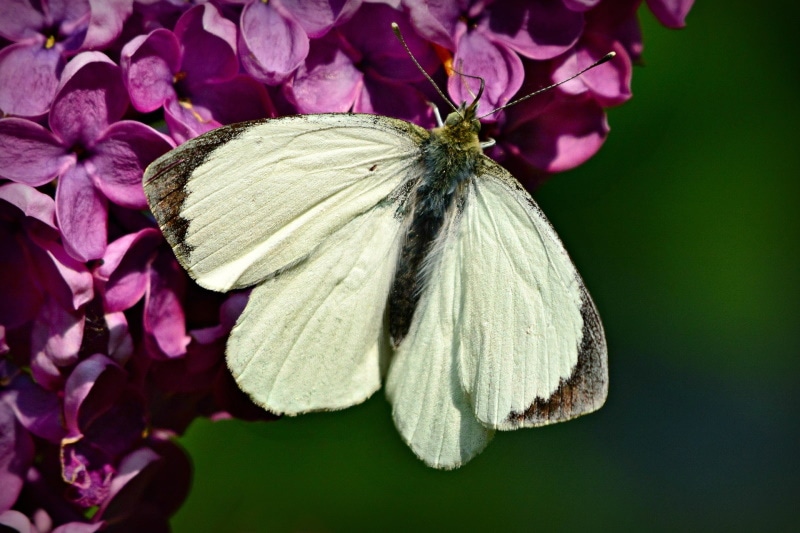
| Scientific Name: | Pieris rapae |
| Colors: | White, tan, gray, black |
The Cabbage White may look dainty and delicate with its small size and pale markings. However, these butterflies are known to cause significant damage to crops, particularly broccoli, cauliflower, and other vegetables in the cabbage family.
Cabbage Whites are often mistaken for Large Whites due to similar markings. However, Cabbage Whites are much smaller. They also lay yellow eggs, and their larvae are bright green. As their name states, these butterflies are most commonly spotted fluttering through cabbage patches and vegetable gardens.
4. Common Buckeye

| Scientific Name: | Junonia coenia |
| Colors: | Brown, orange, white, purple, black |
Common Buckeyes are usually found in the southern parts of Illinois, and they’re known for their stunning purple and black spots on their wings. Females are typically larger than males, and their wings look slightly rounder.
These butterflies can be quite flighty and difficult to watch up close. So, you’ll have better luck if you’re at a distance and using binoculars. Common Buckeye larvae can eat a variety of plants, but they’re most commonly found on American Bluehearts, False Foxglove, and Toadflax.
5. Common Wood Nymph
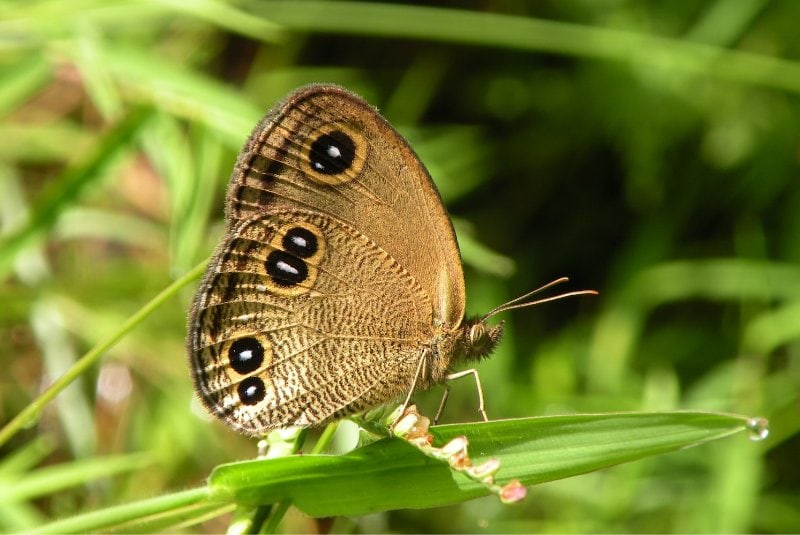
| Scientific Name: | Cercyonis pegala |
| Colors: | Brown, yellow, black |
The Common Wood Nymph is a master of disguise and can be difficult to spot. The surface of Adult Common Wood Nymphs’ wings is brown with yellow-ringed eyespots. The underside has more spots lining the outer edge.
Female Common Wood Nymphs will lay eggs in late summer. The caterpillars will hatch, but they’ll hibernate through the winter. Once winter passes, they’ll start to feed and continue the life cycle.
6. Clouded Sulphur
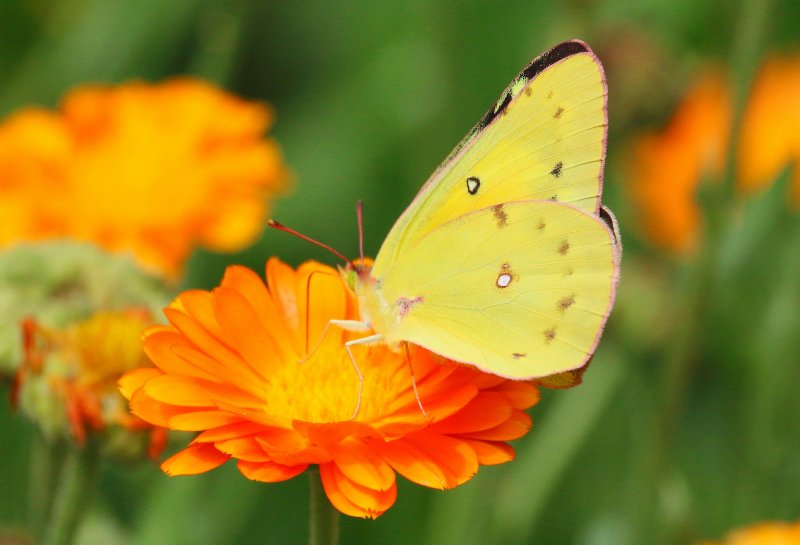
| Scientific Name: | Colias philodice |
| Colors: | Yellow, gray, green |
Clouded Sulphurs can be seen in all kinds of environments, and many Illinoisans are familiar with these bright yellow butterflies. Male Clouded Sulphurs have clean borders lining their wings, while females have yellow dots in the same area.
Clouded Sulphurs lay yellow eggs that turn red after a few days. When they’re ready to hatch, they’ll become gray. Common host plants of Clouded Sulphur caterpillars are Milkweed, Butterfly Bush, Coneflower, and Dandelion.
7. Eastern Comma

| Scientific Name: | Polygonia comma |
| Colors: | Orange, brown, silver |
Eastern Commas have wings with a jagged appearance. Their wings start bright orange on the top and fade to brown as the color travels down the wings. These butterflies look similar to the Question Mark butterfly, except their hind wing has a silver curve that resembles a comma.
Eastern Commas have two forms. The summer form has more black coloring on its wings, while the winter form appears more orange. Females will lay eggs on plants in the elm and nettle families. While caterpillars enjoy eating leaves at night, adult Eastern Commas mostly feed on tree sap and rotting fruit.
8. Eastern Tailed-Blue
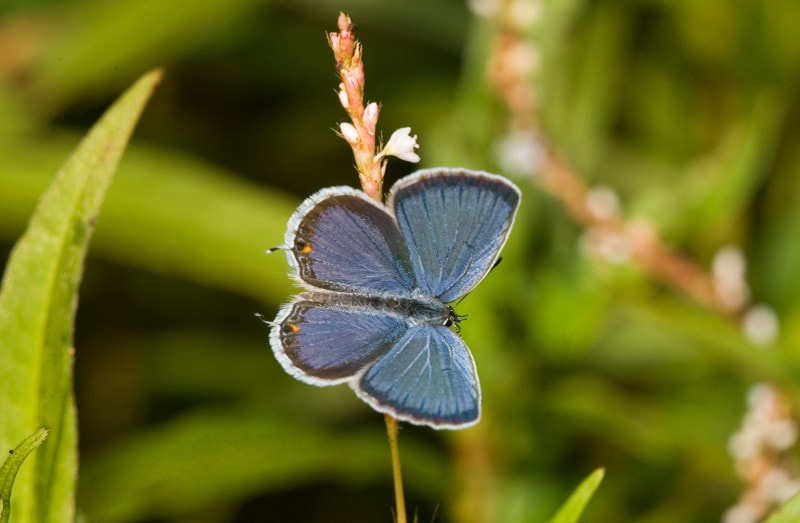
| Scientific Name: | Cupido comyntas |
| Colors: | Blue, black, orange, white |
Eastern Tailed-Blues have beautiful, deep sapphire wings with a neat black and pale blue border. They’re also distinguishable by their small orange spots at the base of their hind wings that lead to short tails jutting out the bottom. Females tend to be darker than males and can even look gray rather than blue.
The underside of these butterflies is much paler and has more orange spots. Females will lay eggs on plants belonging to the pea family. You’ll have the most success finding Easter Tailed-Blue caterpillars on Yellow Sweet Clover, Alfalfa, and Bush Clover.
9. Eastern Tiger Swallowtail
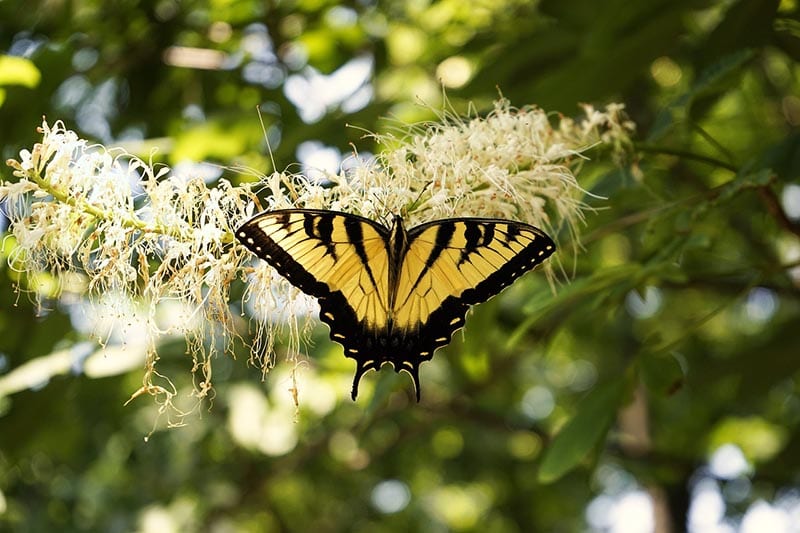
| Scientific Name: | Papilio glaucus |
| Colors: | Yellow, black, blue, orange |
Eastern Tiger Swallowtails are large butterflies with wingspans almost reaching 5 inches. These impressive butterflies have yellow wings with black stripes and borders. Females can be darker than males and have blue markings on the base of their hindwings.
Adult Easter Tiger Swallowtails enjoy feeding on various flower nectar, including Butterfly Bush, Purple Coneflower, and Wild Bergamot. Caterpillars prefer Black Cherry and Tuliptree and are often found in deciduous forests.
10. Eyed Brown
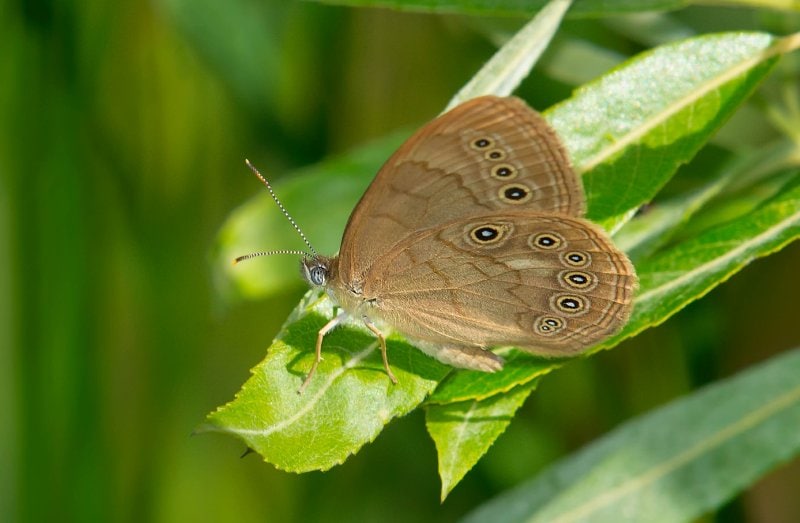
| Scientific Name: | Lethe eurydice |
| Colors: | Brown, tan, orange, black |
Eyed Brown butterflies have tan wings with brown and black spots lining the edges. They’re often mistaken for Appalachian Browns, but they have slightly more vibrant spots. Eyed Browns prefer to live in wet meadows, and they’re known to be slow fliers. You can usually find them lazily floating between blades of tall grass from June to August.
Caterpillars overwinter before they reach the end of their growth stage. They feed on sedge leaves, particularly Tussock Sedges and Lake Sedge.
11. Great Spangled Fritillary

| Scientific Name: | Speyeria cybele |
| Colors: | Orange, black, brown, silver |
Great Spangled Fritillaries have beautiful brown and orange wings with black stripes. The wings are lined with white stripes that make the wing edges appear scalloped. The underside has silvery-white spots and black stripes.
Adult Great Spangled Fritillaries can be spotted between June to October. They drink nectar from common butterfly-friendly flowers, such as Wild Bergamot and Purpose Coneflower. Females typically lay eggs in late summer, and Caterpillars feed on violets and overwinter before morphing to the pupae stage.
12. Hackberry Emperor
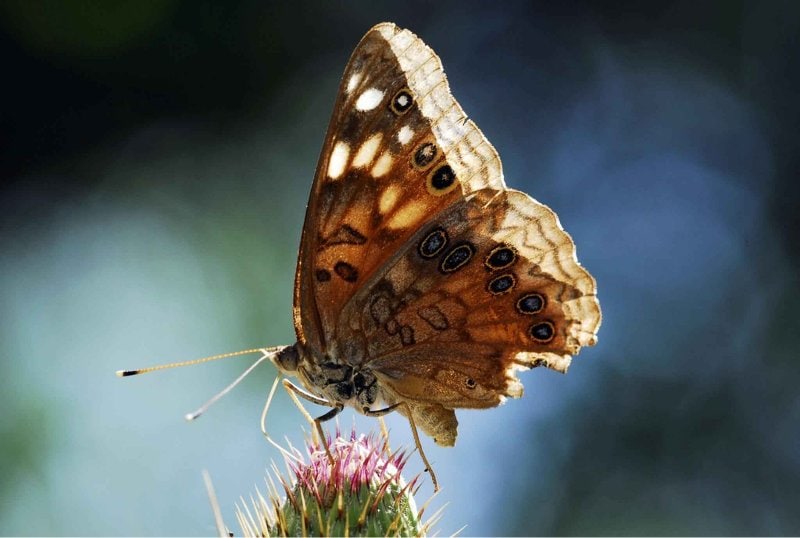
| Scientific Name: | Asterocampa celtis |
| Colors: | Brown, black, white, yellow, gray, turquoise |
Hackberry Emperors prefer living near rivers, and dense swarms inhabit the southern states. However, you can still spot these butterflies in Illinois during the spring and summer. These butterflies have brown and black wings with white, yellow, and black spots. The underside of the wings is black and white with turquoise spots on the hindwings.
As their name states, Hackberry Emperor caterpillars eat Hackberry leaves. Adult butterflies rarely drink nectar and most often feed on tree sap, carrion, dung, and fermenting fruit.
13. Little Wood Satyr
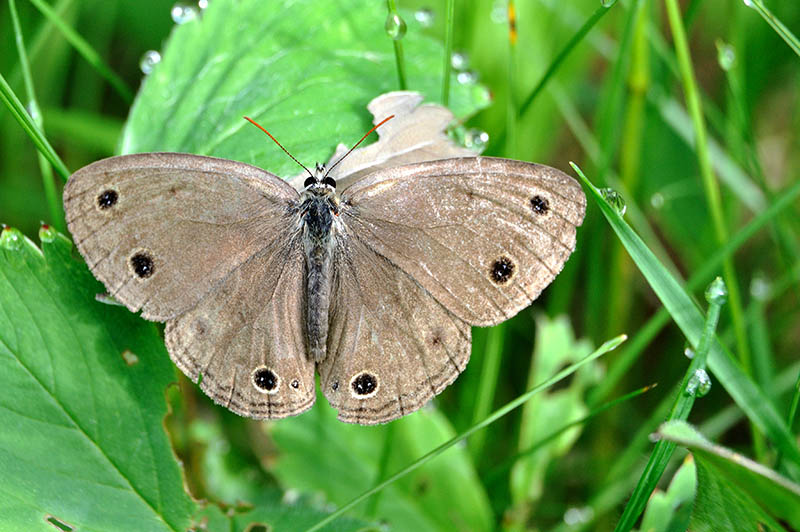
| Scientific Name: | Megisto cymela |
| Colors: | Brown, black, yellow |
Little Wood Satyrs are small butterflies that are common and widespread throughout Illinois. They have black spots with yellow outlines along the edges of their wings, and dark brown lines bordering the ends.
Adults are most active during the day and usually feed on plant sap, fruit, and aphid honeydew. They rarely drink flower nectar. Little Wood Satyr caterpillars typically feed on various types of grass. Therefore, these butterflies are often found in grasslands and prairies.
14. Monarch
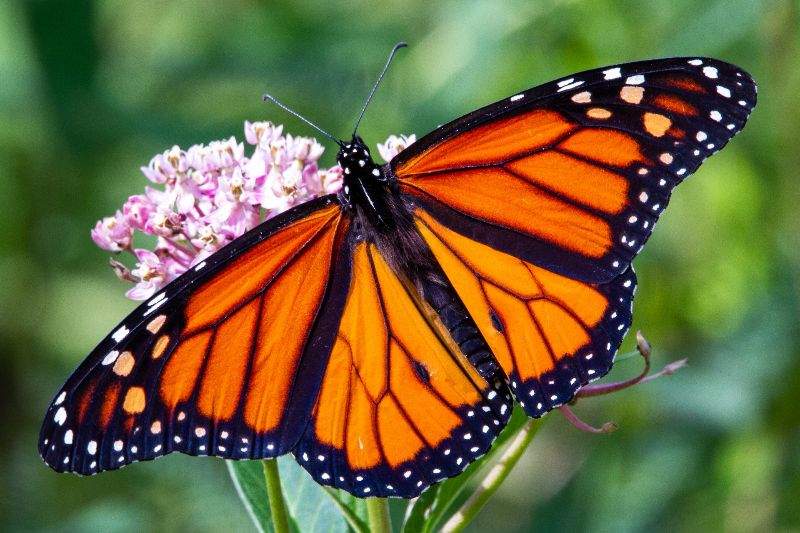
| Scientific Name: | Danaus plexippus |
| Colors: | Orange, black, white |
The Monarch is an iconic butterfly known for its extensive migration journey. These amazing butterflies start in North America and fly through the US until they reach Mexico. It can take between three to five generations of butterflies to complete the journey.
Monarchs also happen to be the state insect of Illinois. You can start to see Monarchs in Illinois in May, and the last of the butterflies remain until October. Monarch caterpillars only eat the milkweed plant, so if you’d like to see them in your garden, make sure to plant a few native milkweed species.
15. Mourning Cloak
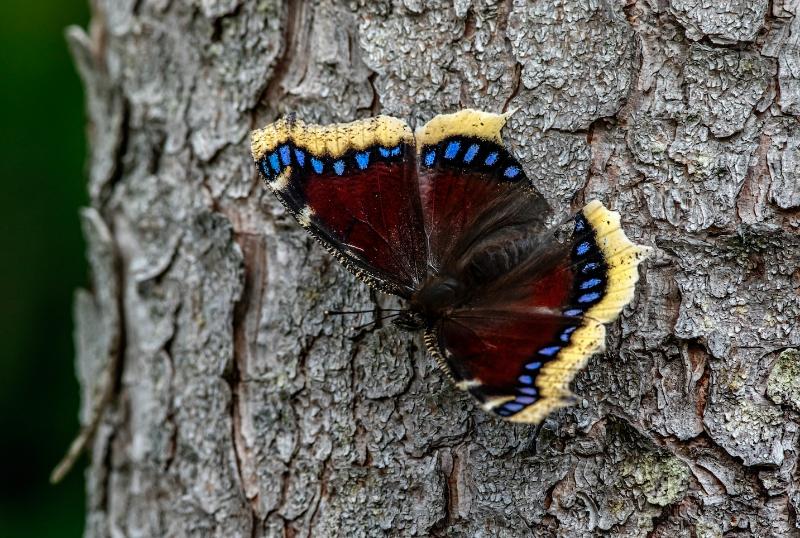
| Scientific Name: | Nymphalis antiopa |
| Colors: | Brown, tan, black, blue |
Mourning Cloaks can be a rare sight, but they can be found in woods, parks, and suburban areas during their migration through Illinois. They have brown wings with a light tan border and beautiful deep blue spots.
Caterpillars prefer eating the leaves of various trees in the elm, willow, and birch families. Older caterpillars can expand their range to eat other types of tree leaves. Mourning Cloak butterflies may have the longest lifespan amongst butterflies and can live for about 10-11 months.
16. Northern Pearly-Eye

| Scientific Name: | Lethe anthedon |
| Colors: | Tan, black, yellow, white |
Northern Pearly-Eyes got their name from the spots under their wings. These spots are black and lined with a yellow border and have white spots in the center. The surface of their wings is brown and has either brown or black spots on them.
Northern Pearly-Eye caterpillars eat a variety of grasses, so they’re often found in marshes and grassy woodlands. Adults eat tree sap and can also feed on fungi, carrion, and dung.
17. Orange Sulphur

| Scientific Name: | Colias eurytheme |
| Colors: | Yellow, orange, black, brown |
Orange Sulphurs have pale orange wings with black edges and two black spots on the upper wings. Some female Orange Sulphurs can be white and look more green than yellow. These butterflies like open spaces and can be found in meadows and pastures.
They prefer sticking to clovers and plants in the pea family. They have a particular liking for alfalfa and can become pests if swarms are attracted to alfalfa patches. Orange Sulphur caterpillars will eat parts of alfalfa, clover, and vetch plants.
18. Painted Lady
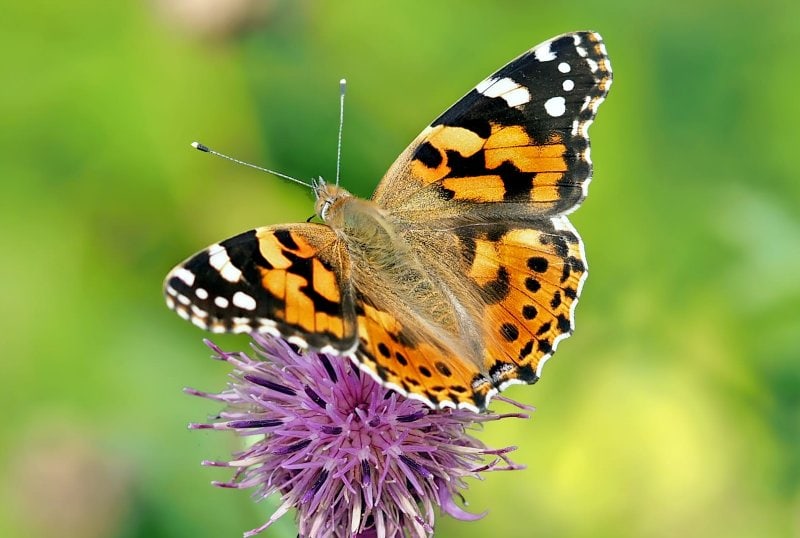
| Scientific Name: | Vanessa cardui |
| Colors: | Orange, black, white, brown |
Painted Ladies are resilient butterflies that go on long migration journeys throughout the year. They have orange wings with black tips and black and white spots. The underside of the wings has some orange in the middle, but it’s mostly black and white with some black bands and spots.
Painted Lady caterpillars are spiky and hairy, and they eat a variety of thistles and nettles. Adult butterflies drink nectar and are known to visit flowering gardens.
19. Pearl Crescent
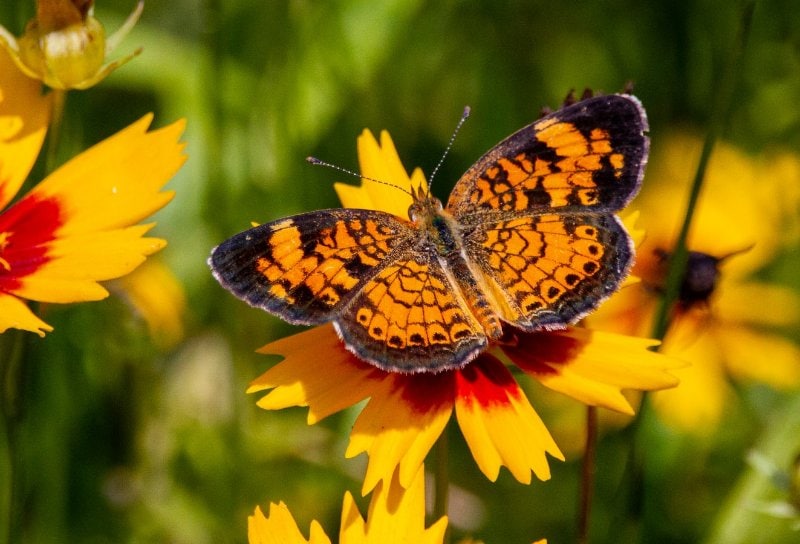
| Scientific Name: | Phyciodes tharos |
| Colors: | Orange, brown, black, white |
Upon first glance, Pearl Crescents look like Monarchs. However, their wings have more black spots and strops on them. The underside of their wings is paler, and some forms can also have some gray in them.
Adult Pearl Crescents drink nectar from flowering plants, while caterpillars strictly eat leaves from plants in the Aster family. They’re gregarious, so if you find one, you’ll most likely find a horde of others nearby. Pearl Crescents are quite hardy and can be found in all sorts of environments, including fields, open woods, road edges, and suburban gardens.
20. Question Mark
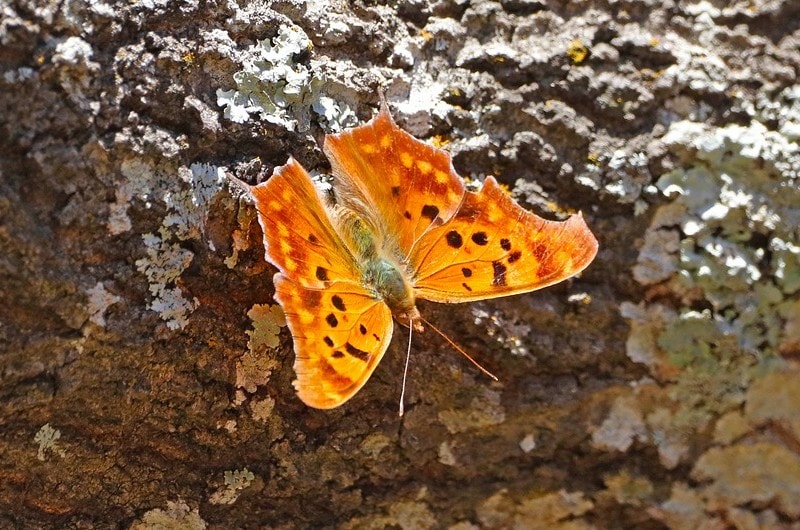
| Scientific Name: | Polygonia interrogationis |
| Colors: | Brown, orange, black, white |
The Question Mark butterfly got its name from the question mark-like stripe found on the underside of its wings. While the underside is mostly varying shades of brown, the surface of the wings is a beautiful black and orange, covered with black spots, and lined with a white border. The wings also have beautiful curves and points.
Question Mark caterpillars are covered in horizontal bands of spikes. They eat the leaves of various elm species. Adult Question Marks rarely drink nectar. They typically feed on tree sap, fermenting fruit, and dung.
21. Red Admiral

| Scientific Name: | Vanessa atalanta |
| Colors: | Black, white, red, orange |
Red Admirals are large butterflies with black wings with white, red, and orange bands and spots. They’re most frequently found in wet areas, including bogs, marshes, and wetlands in forests.
These butterflies lay eggs that range from pale green to cream, and the eggs also have hairs on them. The larvae eat the leaves of plants belonging to the nettle family. Red Admiral caterpillars don’t have any chemical defenses, so they have to camouflage well when they enter the pupal stage. They’re often very difficult to find until they emerge as grown butterflies.
22. Red-Spotted Purple
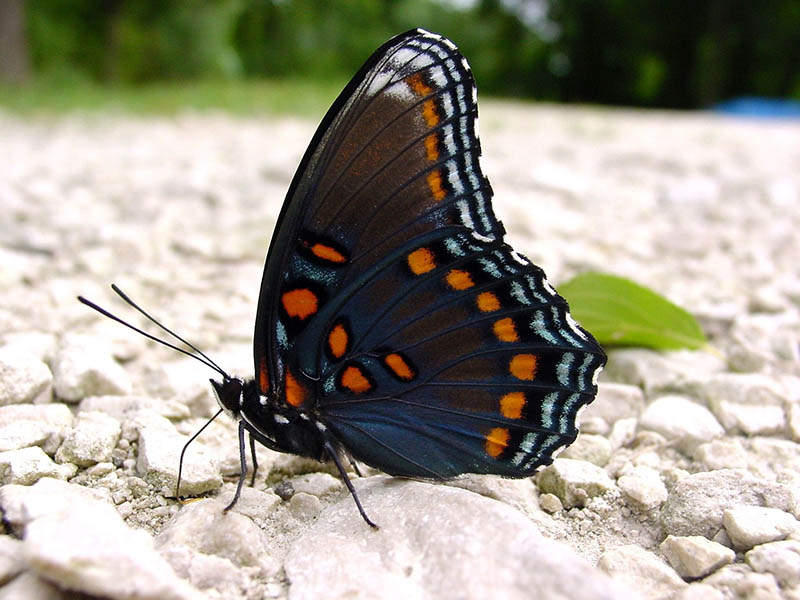
| Scientific Name: | Limenitis arthemis astyanax |
| Colors: | Blue, orange, white, black |
Red-Spotted Purples are beautiful butterflies with iridescent blue wings with black and white stripes. The surface of the wings has flecks of orange, while the underside has vibrant orange spots.
Adults lay white and pale green eggs with spikes, and they eventually turn gray before they hatch. The larvae of this species couldn’t look more different than the adults. Caterpillars have a bumpy appearance and are white, green, and brown. They prefer to feed on Black Cherries and Deerberries and can occasionally be found on willows.
23. Silver-Spotted Skipper
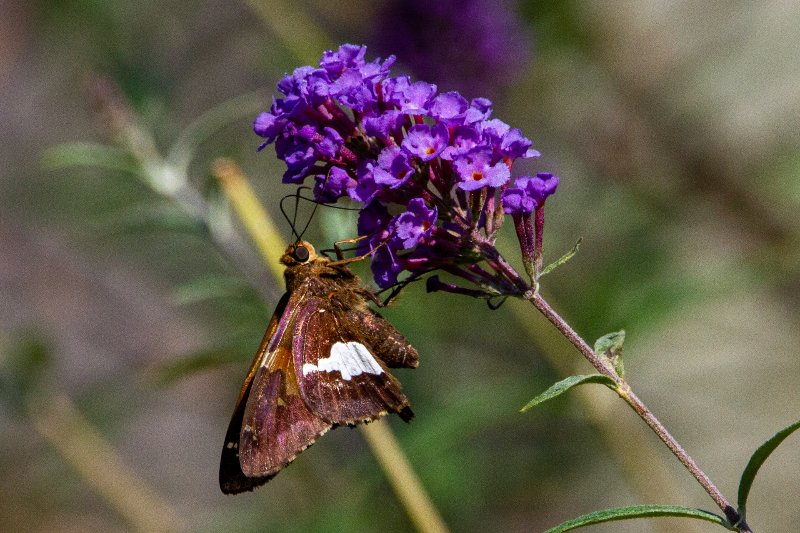
| Scientific Name: | Epargyreus clarus |
| Colors: | Brown tan, white, orange |
Silver-Spotted Skippers are best identified by the prominent white spot on the underside of their wings. The surface of their wings is brown and has golden spots in the middle. The best place to find Silver-Spotted Skippers are in swamps, brushes, and the edges of forests.
Silver-Spotted Skippers lay green eggs with a red top. The larvae feed on all parts of plants belonging to the pea family. They can be found on False Indigo bushes, American Hog Peanuts, and Butterfly Peas.
24. Spring Azure
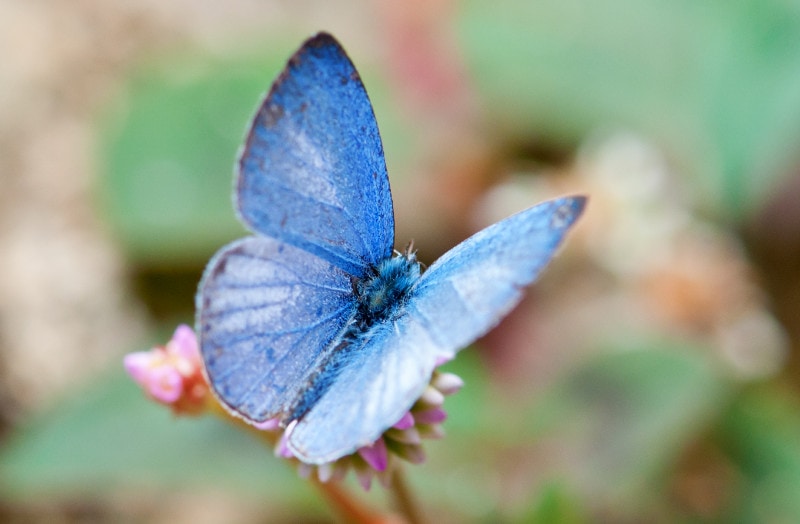
| Scientific Name: | Celastrina ladon |
| Colors: | Blue, black, white |
The Spring Azure has beautiful, shimmery blue wings. While males are bright blue, females are darker blue and have more black coloring on their wings. Three different forms can be found throughout the spring, so it’s important to be familiar with each one to identify them. Some forms can have white on their wings, while others have various black spots.
Spring Azure larvae will eat from the Flowering Dogwood, Inkberry, and American Holly. Once they reach the pupal stage, they’ll overwinter and resume growth in the spring.
25. Viceroy

| Scientific Name: | Limenitis archippus |
| Colors: | Black, white, orange |
Viceroys are one of the best mimics of Monarchs. They share similar orange and black wings, but their color is a bit more muted, and they have an extra black band running across their hindwings.
While Monarch caterpillars only eat milkweeds, Viceroy caterpillars eat the leaves of poplar and willow trees. Viceroy butterflies can eat nectar, but their diet also consists of carrion, dung, and fungi. They can usually be found in meadows, marshes, swamps, and other types of wetlands.
Conclusion
You can find so many unique butterflies in Illinois from spring to fall. Many species drink nectar and will be attracted to flowering gardens. Others prefer eating fruit, tree sap, dung, and fungi. So, it’s worth visiting wooded areas to find different types of butterflies. You just might be pleasantly surprised by all the various butterflies you’ll find and develop a greater appreciation for all the ways Illinois provides wonderful habitats for these fascinating insects.
Featured Image Credit: Cornelia Gatz, Pixabay
Contents
